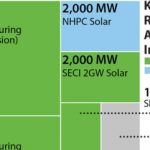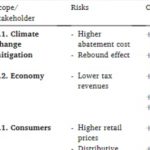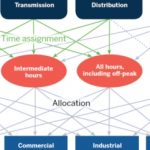What are the sources of investment and sources of finance in the energy sector? Cecilia Tam, Paul Grimal, Jeanne-Marie Hays and Haneul Kim at the IEA summarise insights extracted from the IEA’s latest flagship World Energy Investment report which this year has dug much deeper into the subject. They look at the capital structure (debt versus equity) of energy investments in assets and companies. They look at the entities making the investments, … [Read more...]
Hydrogen too expensive for Trucking? 85% of the cost is getting it to the pump
Hydrogen can be a clean fuel for heavy duty trucking. The target price for rapid adoption is $4-$5/kg, yet right now hydrogen costs $13-$16/kg at refuelling stations in California. Cutting the cost of making the hydrogen is proving slow. But Ted McKlveen and Bav Roy at Verne, writing for WEF, show that the production only accounts for 15% of the cost at the pump. Roughly 50% of the cost is from running the pump station (equipment like compressors … [Read more...]
Make EV batteries bidirectional, get GWs of storage for the Grid
How to cope with the hourly, daily and seasonal variation in demand as regions electrify more, depend more on variable renewables like wind and solar, and cut baseload fossil generation? Storage shifts load nicely. But why build grid-scale batteries when millions of little batteries in our EVs are sitting idle in our driveways for most of the time? As Mark Specht at the Union of Concerned Scientists explains, it’s why in California a bill is … [Read more...]
Electricity Market Design – creating the stimulus for competitive Offshore Wind within the internal energy market
Ahead of the upcoming discussion in Brussels (September 18, 15:00, Polish Embassy REGISTER HERE) on how to stimulate renewable investment, see below for a reminder of what was discussed at our conference before the summer. This time around, following an open address by Wanda Buk, VP Regulatory Affairs at PGE, PGE Baltica's CEO, Arkadiusz Seksciński will be joined by Thor-Sten Vertmann, Electricity Market Design (EMD) expert within Ms Kadri … [Read more...]
Europe’s grid bottlenecks are delaying its energy transition
***While you're here... REGISTER NOW for "REPowering the grid for Solar PV" with the Vice-President of Tauron, DG ENER C, Eurelectric and SolarPowerEurope - Online Wednesday September 20 from 11:00 to 12:15 CEST*** No amount of record sales and deployment in Europe of heat pumps, EVs, solar farms, wind turbines and all the rest will guarantee the region meeting its electrification targets if the grids aren’t ready to integrate them. As … [Read more...]
Hydrogen’s innovation pipeline: signals strong ahead of World Hydrogen Summit in Rotterdam, May 9-11, 2023
The IEA and the European Patents Office have, for the first time, reported on patents filed worldwide to get a measure of the innovations we’re seeing in the hydrogen sector, summarised here by Ian Shine. Overall, Europe and Japan are leading. Although the U.S. is a close third, with 20% of the total, their filings have declined compared to the previous decade. The fastest growth is in China (15.2%) and South Korea (12.2%). There has been a … [Read more...]
Virtual Power Plants: efficiently networked households won’t need new expensive generation
Virtual Power Plants (VPPs) are the next new innovation that can change the landscape of the global energy transition in our favour, cheaply and fast, explain Liza Martin and Kevin Brehm at RMI. Essentially, they link and aggregate hundreds of thousands of households and businesses to manage their electrical devices. Their thermostats, EVs, appliances, batteries, and rooftop solar arrays are coordinated to ensure loads, charging and discharging … [Read more...]
Grid Distribution Systems: access to usage data is uncovering the optimal design for future electrification
The more efficient a distribution grid is, the less likely other potential supply bottlenecks (from lithium for batteries to trained electricians) will slow the transition to greater and greater electrification. State-of-the-art modelling of future grids is already happening, but the robust modelling of the distribution system is conspicuously missing because good data are notoriously hard to find, says Meredith Fowlie at UC Berkeley’s Energy … [Read more...]
Replacing centralised power with Distributed Energy Systems needs new policies and coordination
We need integrated resilient smart grids that can accommodate the rapid growth of intermittent renewables as well as the rise of “prosumers” who both buy and sell electricity into the grid. This is the focus of three online discussion sessions on February 8th, 9th and 10th organised and hosted by power management company Eaton. The proliferation of multiple generation sources (solar, wind, batteries and other clean, flexible technologies) means … [Read more...]
Can full-scale Distributed Solar really save $473bn in grid investments?
A giant model of the entire US electricity sector which captures distributed energy resource (DER) potential has been getting a lot of attention. It estimates that distributed solar and storage can save $473bn in system-wide costs when deployed at scale (enough to power more than 25% of US homes). Rooftop solar is definitely much more expensive than grid generation, but its location (on your own roof) avoids a range of costly transmission and … [Read more...]
Solar is displacing Coal in India’s electricity market
India is the world’s third largest electricity market and as a fast-growing economy can, according to the IEA, lead the recovery of global energy demand out of the pandemic for the coming decade. Kashish Shah at IEEFA runs through solar’s prospects in India, which hopes to build 450GW of renewable energy by 2030. Solar is getting cheaper. A 2GW auction in June delivered India’s lowest-yet renewable energy tariff at US$31/MWh. That figure could … [Read more...]
Rooftop Solar: economies of scale can challenge the centralised grid
One of our recent articles explained how rooftop solar PV is more expensive that a centralised supply, and that the transmission and distribution cost savings of the rooftop system, on their own, do not make up for this cost difference. Here, Javier López Prol at the Wegener Center for Climate and Global Change, University of Graz, responds to those challenges. First, the economies of scale of distributed rooftop solar are yet to be realised. … [Read more...]
Why promote Rooftop Solar when the Grid is so much cheaper?
Is rooftop solar in the U.S. getting more support than it deserves? One main argument from its advocates is that it will cut grid transmission and distribution costs that total hundreds of millions. Severin Borenstein at the Energy Institute at Haas crunches some numbers to try to uncover the true “avoided costs”. He shows that any savings won’t come even close to making up for the higher cost of rooftop electricity. It’s no match for the grid’s … [Read more...]
The new era of electricity needs modern ways to charge customers
Today’s technologies – wind, solar, storage - have widely differing cost and operating characteristics to fossil fuels. So the way customers are made to cover those costs – assigning different rates to different customer classes – should change. Jim Lazar and Mark LeBel at RAP explain why and how, referencing their comprehensive manual “Electric Cost Allocation for a New Era”. They describe how the full range of technologies now establishing … [Read more...]
Ukraine’s integration into the EU gas market is a positive lesson for the region
Ukraine is shaping its gas infrastructure and regulations to integrate into the EU market. On the infrastructure front, its interconnectors with neighbours, extensive pipeline network and storage facilities are making it an increasingly important European player, explains Aura Sabadus writing for the Atlantic Council. The gradual opening up to EU free market rules are evidenced by its gas prices following those of the EU. Ukraine's attractive … [Read more...]
















